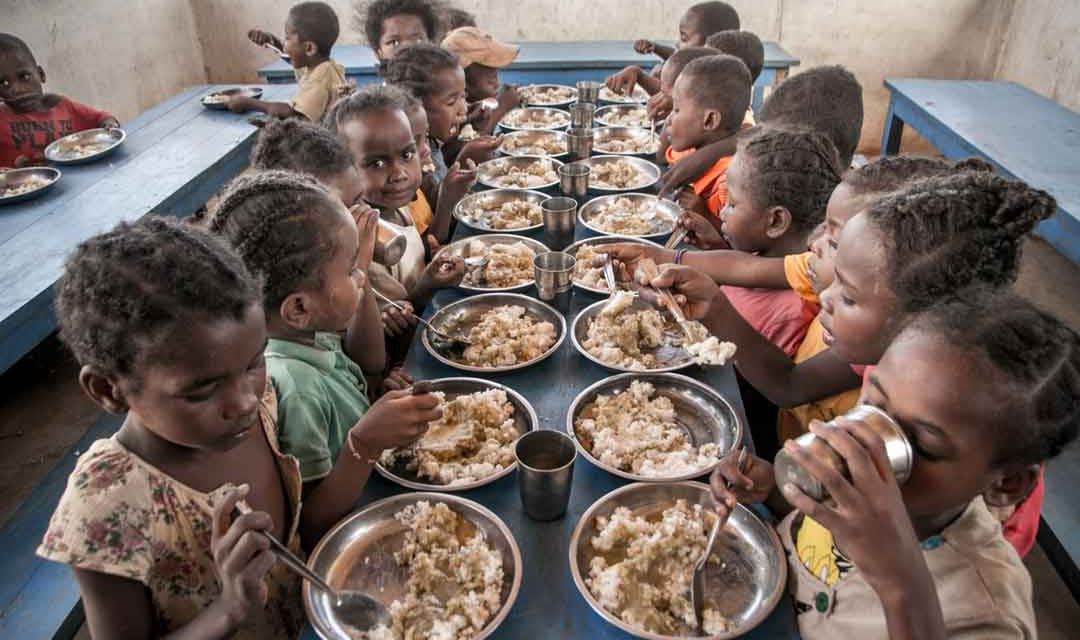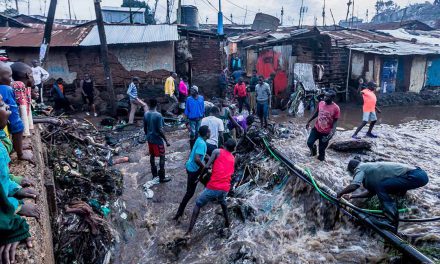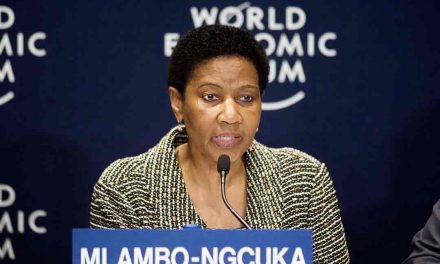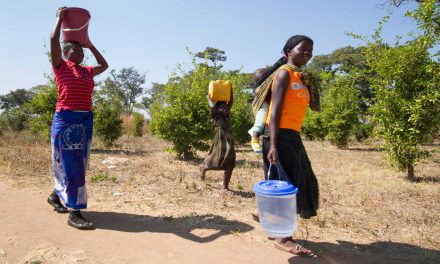SDG 1: poverty
Africa will be home to 87% of the world’s poorest people by 2030, but that shocking figure hides the real progress made by some countries
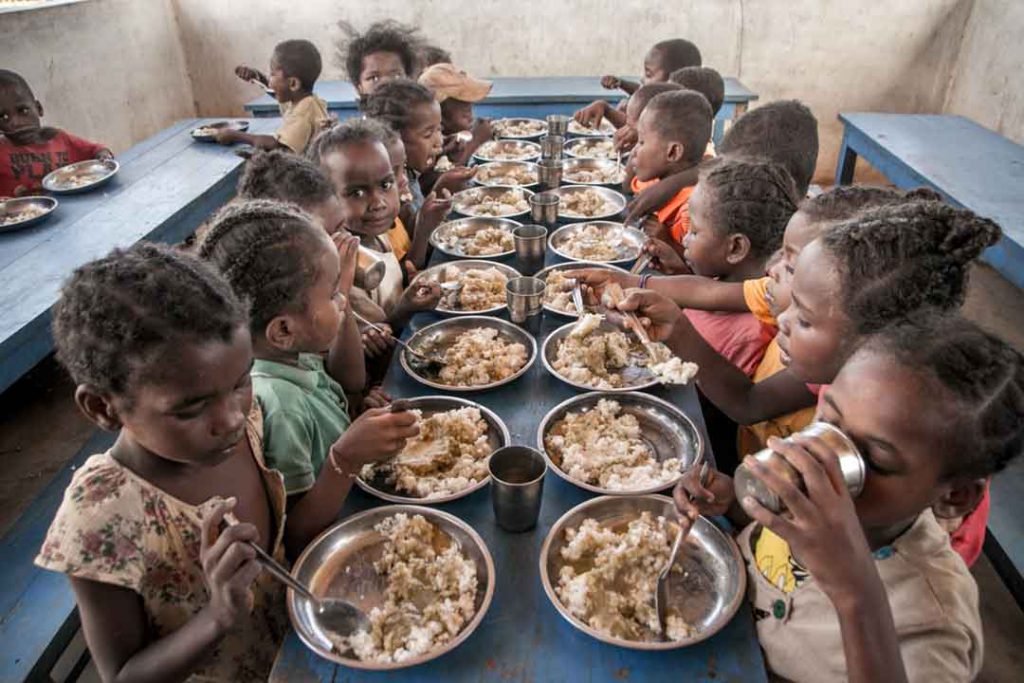
Children at the Ankileisoke Primary School in the Amboasary-South district of southern Madagascar eat lunch offered by the World Food Programme in December 2018. Photo: RIJASOLO/AFP
By Richard Jurgens, Susan Russell and Charmain Naidoo
In 2004, the former Soviet president Mikhail Gorbachev told world leaders: “We are all agreed that poverty is the key problem of our times.” He called it “a political problem” since the world had enough resources to solve it – if decisions to solve it were taken. “But the problem has not been solved. It’s becoming more acute and political will is needed,” Gorbachev told the World Political Forum. In 2000, the UN’s Millennium Development Goals (MDGs), launched that year to run until 2015, challenged the world’s countries to face up to the need for conscious, focused developmental goals. The MDGs aimed to halve the number of people earning less than $1.25 a day; that is still the poverty measurement for the much more ambitious 17 SDGs the UN set in 2015 aimed at achieving a more equitable world by 2030. SDG 1 ambitiously pledges to “end poverty in all its forms everywhere” by 2030, reducing “at least by half the proportion of men, women and children of all ages living in poverty in all its dimensions according to national definitions.”
SDG 1, sections 1.4 and 1.5, further outline the scope of what it hopes to achieve: “ensure that all men and women, in particular the poor and vulnerable, have equal rights to economic resources, as well as access to basic services, ownership and control over land and other forms of property…. build the resilience of the poor … and reduce their exposure to climate-related extreme events and other economic, social and environmental shocks.” A World Bank poverty report published in September 2018 suggests that from a worldwide perspective at least, SDG 1 is within reach, stating that, “extreme poverty has rapidly declined. New poverty estimates by the Word Bank suggest that the number of extremely poor people – those who live on $1.90 a day or less – has fallen from 1.9 billion in 1990 to about 736 million in 2015.” Except in Africa, where 422 million Africans (more than 70% of the world’s poorest people) currently live below the global poverty line.
While projections indicate that figure will decline to 377 million by 2030, if current trends continue, the World Bank predicts that by that date nine out of 10 (87%) of the world’s extremely poor people will be living in sub-Saharan Africa. On the face of it, these are shocking statistics, but a Brookings Institute report, published in March this year, Poverty in Africa is falling – but not fast enough, written by Kristofer Hamel, Baldwin Tong and Martin Hofer, suggests a more nuanced picture. According to Hamel et al, World Data Lab projections reveal that in 2019 more Africans are escaping extreme poverty than are falling below the poverty line – for the first time since the start of the SDGs. While the number is small – at 367 people a day – the rate is projected to rise, resulting in a million fewer African people in extreme poverty by 2020, and rising to 45 million fewer by 2030. Current projections still have Africa as a continent falling far short of achieving SDG 1 by 2030, but a closer look at what is happening at a national level reveals that several African countries will have ended, or be close to ending, poverty by then.
The Brookings report points out that four African countries – Equatorial Guinea, Gabon, Mauritius and Seychelles – already have poverty rates below 3%, with Mauritania and Gambia projected to join them by 2030. They also cite several countries that are close to achieving SDG 1 by 2030 if current trends continue, or will be very close to doing so. Ethiopia, for example, is projected to lift 22 million people out of poverty by 2030, reducing the current percentage of extremely poor people (24%) today to 3.9%. If Ethiopia can accelerate this process it will achieve SDG 1 by 2030. Even with demographic challenges, Ghana is projected to reduce its extremely poor population from 12.5% to 4.5% by 2030, Kenya from 20.9% to 4.3% by then, Côte d’Ivoire from 17.2% to 4.9% and Dijbouti from 14.2% to 4.6%. This means, they say, that if current trends remain the same, Ethiopia and Kenya will achieve SGD 1 in 2032; Ghana, Angola and Côte d’Ivoire in 2033; and Djibouti in 2034.
In Angola, poverty has been on the rise again since 2017, but the World Data Lab says this trend will reverse, with the extreme poverty rate falling again by 2021, dropping to 3.5% of the population by 2030. Hamel et al say that if the rate can be reversed sooner, Angola stands a good chance of achieving SDG 1 by 2030. The Brookings Institute report says that it is important to note that the continent has turned a corner, even if at this point it seems almost impossible that Africa will end extreme poverty by 2030. That said, it is important to look at the reasons for Africa’s uneven scorecard in working towards achieving SDG 1, both as a continent and at the national and regional level. As the Brookings report points out, the most significant challenges to reducing poverty in Africa are found in just two countries, Nigeria and the Democratic Republic of Congo (DRC). “Taken together, the 150 million citizens of these two counties represent more than a quarter of total poverty in Africa today – and are expected to represent almost half of Africa’s poor by 2030,” Hamel et al write.
In this context we might ask: what are the specifically African problems in addressing poverty? Following decades of dependency theory, which cast African politicians and their societies as perennial victims, it is becoming necessary to emphasise the agency of African actors. With this in mind, we can ask, first, whether African polities, at least in countries such as the DRC and Nigeria, simply lack the political will to address poverty. Moreover, African societies obviously act in a global environment. So, secondly, will the current high growth rates seen in some African countries help to end the continent’s endemic poverty? And thirdly, what sort of government policies would be necessary to begin the eradication of poverty and underdevelopment in Africa? Answering these questions will help to better understand how likely it is that Africa will meet the goals set by SDG 1 for 2030. Interestingly, these questions, and variants, have been around for a while – and relevant answers.
For example, in 1999, Tony Killick of the Overseas Development Institute (ODA) asked that first, critical question: why is poverty not a political issue in most of Africa? Even then, he was able to point out that the view that African growth rates would themselves “solve” poverty was over-optimistic. This was because internal factors to African societies contributed to the problem of poverty. In particular, he argued, inequalities within African societies reduced the contribution of growth to alleviating poverty. The nature of African poverty also posed a serious problem, he suggested: many of the continent’s poor – among them the disabled, the aged, orphans, refugees, widows, abandoned wives, as well as the landless, the unemployed, subsistence farmers, pastoralists and some of the urban poor – would simply not be able to benefit from economic growth.
Similarly, Howard White of the ODA addressed the problem of the policies that would contribute to alleviating poverty in Africa by suggesting that the role of governments should be to reduce the barriers to participating in economic growth experienced by so many sectors of African societies. Investment in health services, in education and in infrastructure would be crucial – but “governmental interventions [had] not always been successful”. As examples, he pointed to labour markets and land reform. In the first case, policies that restricted informal economic activities were common across the continent. As regards land reform, in many cases, “traditionally based systems of land access provide more benefit to the poor than market-based ones”. According to a 2018 World Bank report, slower growth rates, war, weak institutions, famine, natural disasters and a prevalence of authoritarian regimes were among the main factors behind Africa’s higher poverty levels.
While the report stopped short of blaming Africa’s shocking statistics on a lack of political will, it did say that there was “a lack of success in channelling growth into poverty reduction”. Andrew Dabalen, a practice manager for southern and West Africa with the World Bank’s Poverty and Equity Global Practice, says it’s difficult to measure political will. “Sometimes, even if the will exists, it is hard to achieve results. Political will depends on leadership, citizen engagement, and societal goals,” he told Africa in Fact. “One way to encourage political will is to encourage citizens in Africa to engage in the political process and to hold their leaders accountable to reducing poverty in their countries.” A shift in poverty from South Asia to sub-Saharan Africa is already in motion as extreme poverty levels – and the number of poor people – decline in South Asia. Meanwhile, as already mentioned, the World Bank report predicts that as much as 87% of the poor will live in sub-Saharan Africa in 2030.
These mixed figures reflect a tidal change in poverty reduction. The fact that extreme poverty is at the lowest in recorded history is due in part to the massive social changes resulting from technological innovation, which is giving new capabilities of communications and information exchange to large swathes of the world population, the report says. And, as compared to even a decade ago, billions of people are connecting to the financial system. Researchers Zorobabel Bicaba, Zuzana Brixiova and Mthuli Ncube, in a 2015 article published on the International Growth Centre website, Eliminating Extreme Poverty in Africa: The Role of Policies and Global Governance, said although extreme poverty in sub-Saharan Africa was unlikely to be eradicated by 2030, they believed it could be reduced to “very low levels”. Serious commitment to eliminating extreme poverty in sub-Saharan Africa would require a three-pronged approach, they said: first, structural transformation, which required macroeconomic policies, infrastructure investment, and “inclusive growth prioritising productive employment”.
Second, “cautious integration, inviting trade and foreign direct investment (FDI) flows to support regional growth”. And third, “improved global governance, which created space for meaningful representation of African perspectives”. “The lessons from China suggest that to reduce poverty African countries should focus on raising agricultural productivity, which in turn facilitates structural transformation, as manufacturing absorbs workers from rural areas,” said Bicaba et al. “Equally important, Brazil has shown that governments can help reduce poverty through well-designed redistributive programmes and social protection, so far missing in most of Africa.” It seems fair to say that behind Africa’s shocking extreme poverty figures projected for 2030, both the gains – and grim realities – at national level across the continent indicate real difficulty in treating Africa as an amorphous mass in assessing whether it will, or won’t, achieve SDG 1 by 2030.
It is worth repeating that just two countries – Nigeria and the DRC – will account for almost half of Africa’s extreme poverty by the end of the next decade. Both are resource-rich countries hobbled by political instability and corruption. As Bicaba and his colleagues point out, “Africa’s countries need to find their own path, depending on their circumstances and priorities.”

